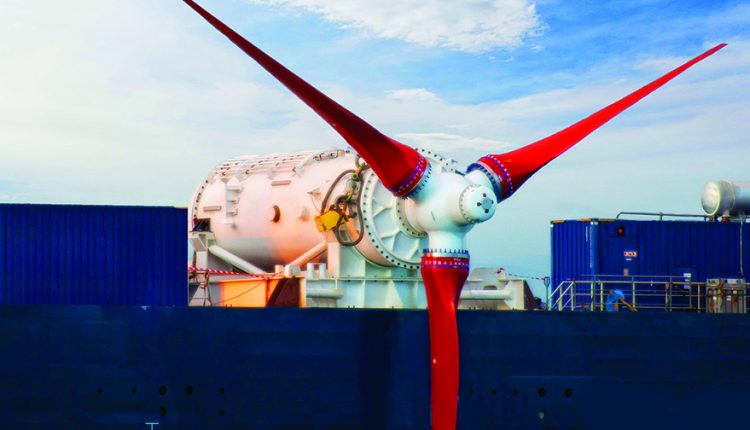Tidal turbines leverage a practically inexhaustible renewable resource by converting the energy of tidal flows into electricity. Located in areas of high tidal energy, these generators require reliable and robust braking systems to handle challenging environmental conditions, avoid shock loads in the drivetrain and protect all the various components.
This is even more important in large infrastructures, such as 1MW units, in order to ensure optimal, round-the-clock speed control and stopping. Svendborg Brakes and its portfolio of advanced, high-quality braking solutions were chosen to address these needs and deliver an ideal tidal turbine setup for installation at the European Marine Energy Centre (EMEC)’s test site.
Effective and robust tidal turbine generators must be able to successfully operate in the harsh and unstable conditions that characterise their operating environment. In particular, tidal turbines must have the ability to control their speed, acceleration and deceleration at all times, even during power or generator failures.
In these situations, braking mechanisms are fundamental to avoid runaway conditions. In a short time, these can lead to overspeed of the entire equipment, resulting in extreme mechanical stress on the turbine and its blades. Responsive brakes can counteract these issues by applying a sufficient torque that maintains the rotational speed below the allowable limit.
In addition to reacting quickly to faults and anomalies, braking systems should also prevent the turbine from coming to an immediate halt. In order to protect the brake pads and the entire drivetrain, ‘soft braking’, i.e. stopping the machine in a gradual and controlled way, should be preferred.
Finally, as any piece of equipment in tidal turbines, the braking system must comply with DNVGL–SE-0163 and DNVGL-ST-0164 standards to ensure it meets set specifications and quality benchmarks.
A producer of tidal turbines was building a large 1 MW unit for installation at EMEC’s wave test site in Billia Croo, off the west coast of Orkney. The manufacturer wanted a regulatory-compliant, advanced braking system able to minimise the effects of unexpected power or generator failures on its operations. To address these needs, Svendborg Brakes, a brand of Altra Industrial Motion Corp., was asked to develop a suitable solution.
The two businesses successfully collaborated in the past on a smaller 300 kW tidal turbine. During this project, the turbine manufacturer was impressed with the Svendborg Brakes’ extensive experience in the production and supply of advanced braking solutions, even to the most demanding industries.
To create an adequate braking system for the intended application, Svendborg Brakes worked closely with the tidal turbine OEM. By establishing a strong collaboration with the customer, the engineers could understand what key design elements and functionalities were expected, thereby delivering a unique solution.
Michael Nygaard-Nissen, Global Key Account Manager at Svendborg Brakes, explained: “While the braking system developed for the 300 kW turbine was relatively simple, this larger application required more advanced features. One particular challenge experienced during the design phase was combining all of these features while maintaining a compact layout that would fit into the limited space available. The expertise of Svendborg Brakes’ engineers and our commitment to delivering an ideal setup for specific applications proved crucial to addressing this issue.”
The resulting system developed by Svendborg Brakes relies on two BSFI 3000 mono-spring, hydraulically-released brakes. These provide 120,000 N clamping force each to meet the high torque needs required by the application. Also, the mono-spring nature of the brakes allows them to accommodate any vertical movement of the brake disc without having it touch the pads during normal operation.
The hydraulic brakes are connected to two 2-stage hydraulic power units (HPUs), in order to offer redundancy. The units are operated by a SOBO (Soft Braking Option) control system, which is able to detect runaway situations. SOBO uses proportional integral (PI) algorithms to handle the fast dynamics of the braking process in a highly efficient and reliable way. As a result, the system can counteract overspeed in a matter of milliseconds as well as providing a smooth stop, preventing mechanical overload of the drivetrain.
In addition to controlling the speed of the brake disc, the HPUs are able to monitor a wide range of process parameters. More precisely, Svendborg Brakes equipped them with key sensors to measure oil level, temperature, pressure, motor and pump functioning. Operators can access all the data remotely, optimising visualisation and diagnostic activities.
After designing such an advanced braking solution, Svendborg Brakes also took care of preparing all relevant documentation for DNV certification as well as manufacturing and installing the braking equipment. As a result, the tidal turbine OEM could benefit from a one-stop-shop for all its braking needs.
The 1 MW unit is now fully operational at European Marine Energy Centre (EMEC)’s wave test site, and the bespoke braking system has been working smoothly since its installation. Michael Nygaard-Nissen continued: “We are pleased with the outcome of this project and delighted to know that the customer is happy with our support and the solution delivered. Key elements that they particularly appreciate are redundancy and the possibility to control the machine remotely, which help to substantially reduce maintenance cost and downtime.”

